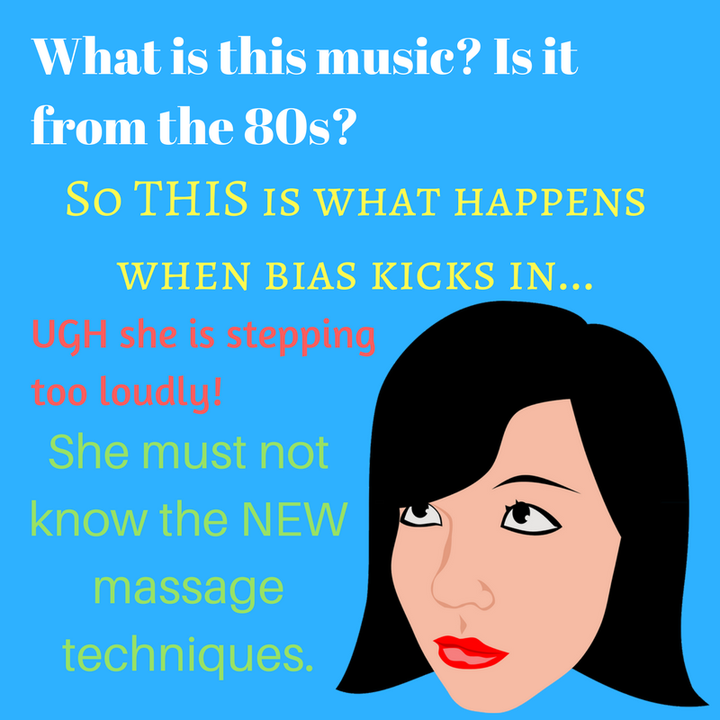“No, not her!” I thought to myself.
What I needed was a massage and my regular massage therapist wasn’t working. I couldn’t believe I got stuck with HER instead.

My mind started racing. “Is she strong enough to give the deep massage I like? Can she really handle a full hour on all my shoulder knots?”
I’d seen her before as I was waiting for my appointment. She was a practitioner in her late 50’s. My immediate thought was, “Wow, she looks old for this job.” But I dismissed the thought, realizing I was just being biased.
Yet when the reality hit that this “older” woman was going to be giving me my massage, I couldn’t control my mind. “You hate ageism,” I reminded myself, “so knock it off.” I smiled and told her what type of massage I prefer.
When the massage started, I immediately noticed she had a very different style than my usual therapist. “Ugh,” I thought, “is this some technique she learned 20 years ago? I guess she doesn’t know the NEW massage techniques.”
“Stop it,” I said to myself again, “quit being biased and relax.”
But I couldn’t. Because she was stepping too loudly on the floor, or breathing too hard. I even thought, “What kind of music is this? Is this from the 80’s?”
As someone who writes and speaks about age bias in the workplace, I knew exactly what was happening to my brain. To be specific, my inner dialogue trifurcated into:

- A running monologue about every little thing she was “doing wrong”
- A 30,000-foot view of “Oh, so this is what happens when bias kicks in. Look how it’s running over every other thought.”
- Scrolling through bias management tips (link), such as “Calm down. Breathe deep. Relax. Enjoy.”
Despite these three conversations monopolizing my mind, the monologue about what she was “doing wrong” steamrolled everything. For all I knew, the music playing could have been the exact same music my regular practitioner plays. This new therapist could be the most revered in the community! I couldn’t see any of that though, because my bias was holding me hostage.
Why Was This Happening To Me?
While I take full responsibility for my biased thinking, there is a scientific aspect to those behaviors as well. The culprit is the amygdala part of the brain, which is responsible for rapid visual predictions and categorizations. For example, friend or foe? In-group or out-group? This part of the brain is useful in that it enables us to recognize danger quickly. However, the rapid categorizations are made before the frontal cortex can consciously think.
Yet, if this were just about danger, my brain wouldn’t have reacted the way it did to an older massage therapist.
The compounding factor here is our culture. It is filled with stereotypes. Many of us have inaccurate and prejudicial information that is quickly accessed before the other part of our brain can analyze. This is why biases are so dangerous; they are reinforced almost unconsciously in our culture, and the outcome is often much more serious than a woman not being able to relax on her massage table.
Fortunately, the amygdala doesn’t completely run the show. We have a highly complex frontal cortex, which allows us to control impulses, make complicated decisions and behave in ways that are socially appropriate. This frontal cortex helps moderate gut reactions.
So remember, despite what it might appear like, the human mind is actually extremely adept at control and regulation. With the awareness and willingness to put some work in, we can grab hold of our biases and tell them to get out of our heads. Start by taking a good, hard look at yourself and be honest about the biases you have. Then try these tips to help manage them.

1. Ask Yourself Questions
When you notice a bias popping up, take a minute to ask yourself these questions:
- Is this bias relevant?
- Does this bias help anyone, including me?
- Why is my brain acting like this bias is important?
- Where did I get this bias?
Looking hard at biases can often not only make you realize they are useless, but also make them less attractive to you.
2. Surround Yourself by Those You are Biased Against
Whether it’s older people, people of a certain ethnicity, certain religious groups or otherwise, if you find you are biased against them, find a way to interact with the group in a positive way. This could be as simple as going to restaurants in parts of your city you don’t usually go to. You can also volunteer in social programs that allow you to work amongst people you tend to be biased towards, join community clubs, attend events, and even simply watch certain movies. The goal here is to challenge your perceptions of certain groups of people, and thereby create new gut reactions when you encounter those like them.
3. Ask Trusted Friends and Family to Hold You Accountable
Because biases are often unconscious, we may not even realize we have them. If you truly want to tackle your personal biases, ask friends and family to call you out when you behave in biased ways or make biased comments. It’s not easy being confronted but control your urge to be defensive, have an open mind, and thank your friend or family member for helping you on your quest to control your personal biases.
I am embarrassed to say that my bias was front and center that day, just because the person looked older than what I expected a massage practitioner to look like. Did my bias impact my massage? Yes, because I was unable to relax. Did it impact her? No. So at the end of the day, my own bias just made it worse for me.
Take a deep look and think about how your own biases may have impacted you in a negative way. I’d love for you to share your experience. Leave a comment below, send me an email, or find me on Twitter.
Bias infiltrates all aspects of our lives— including the workplace. Your organization is not immune. Read “This Type of Bias is Happening at Your Organization Right Now,” to see the bias that’s likely happening now, and learn how to counteract that bias.
